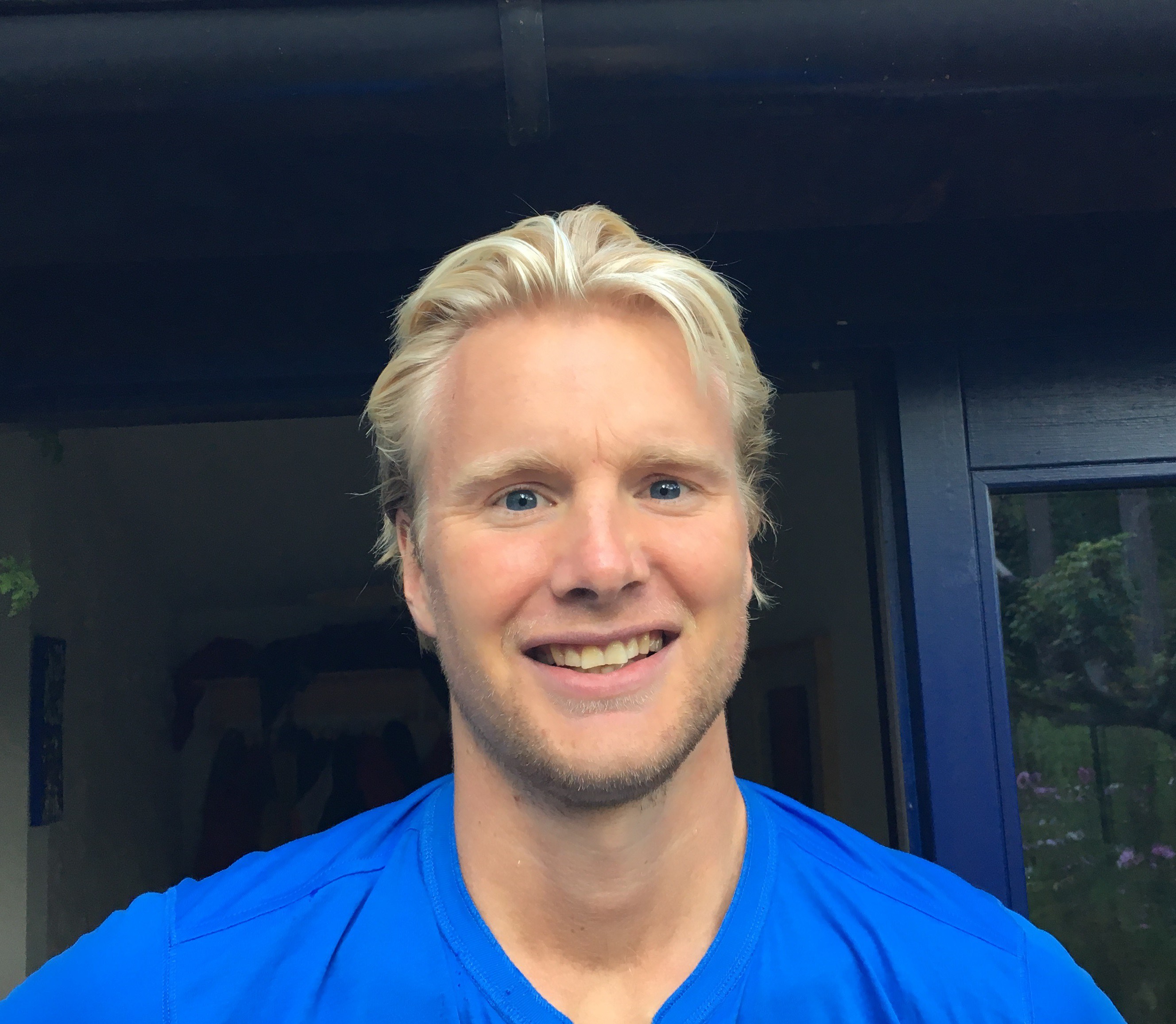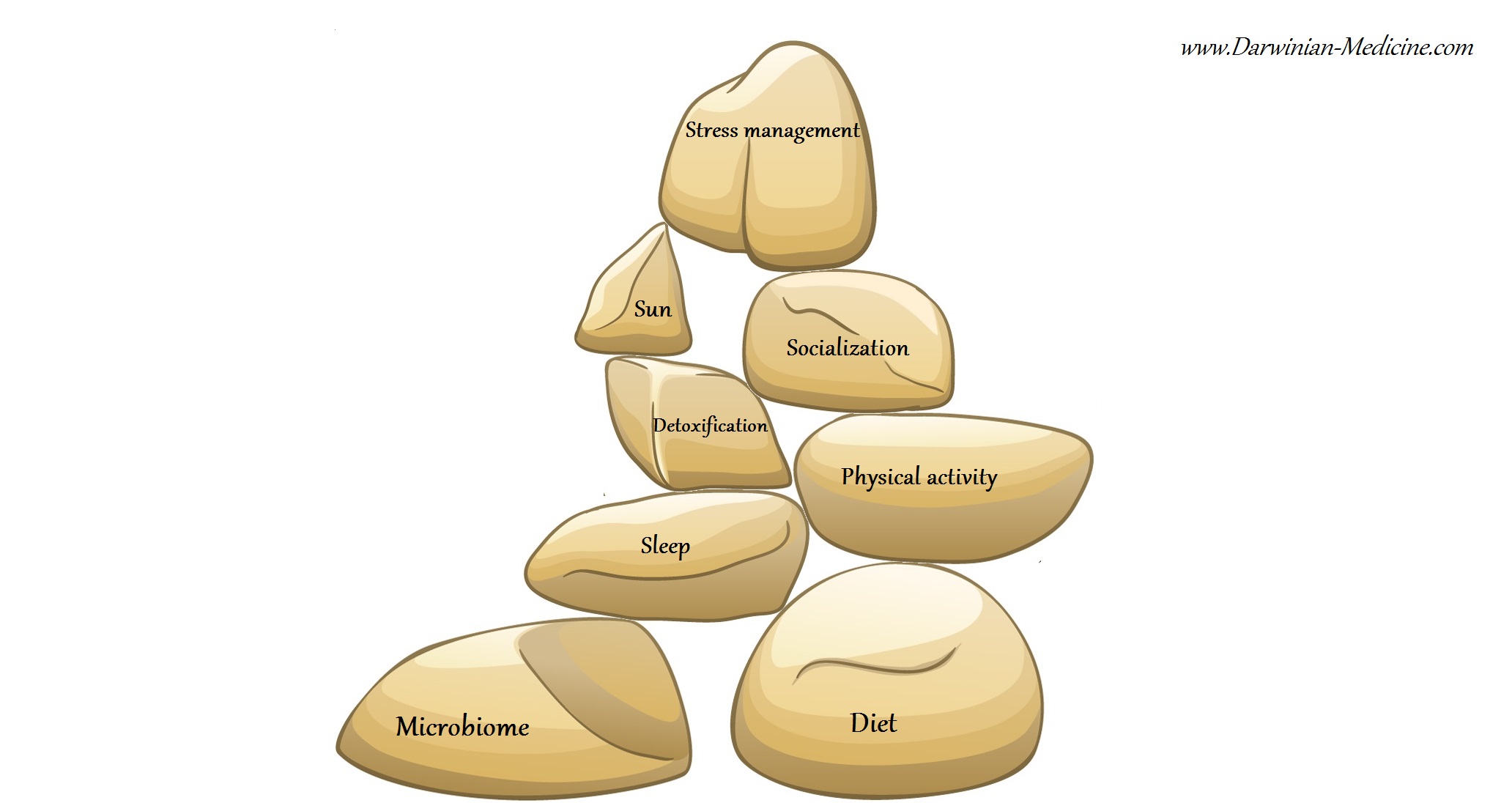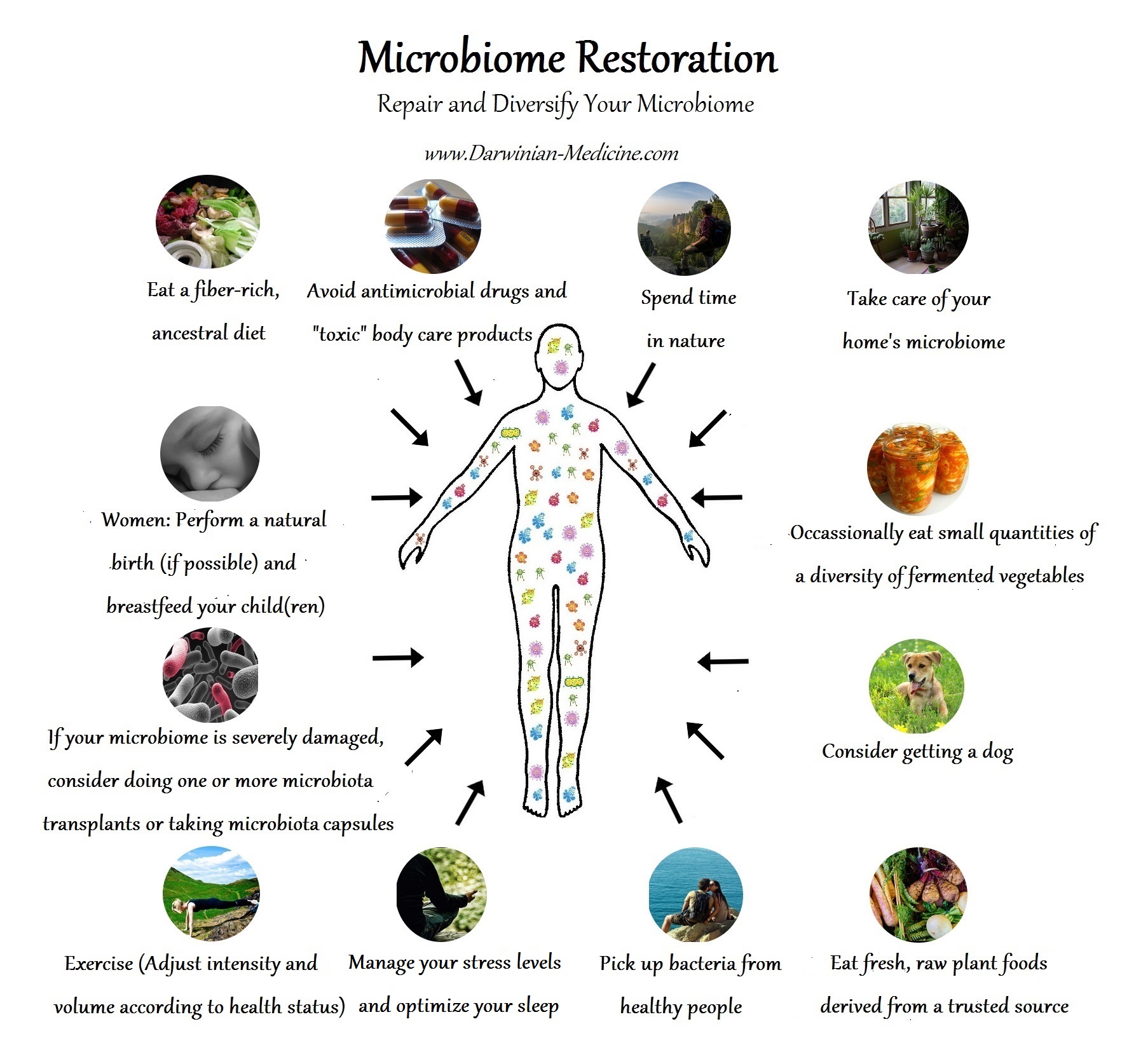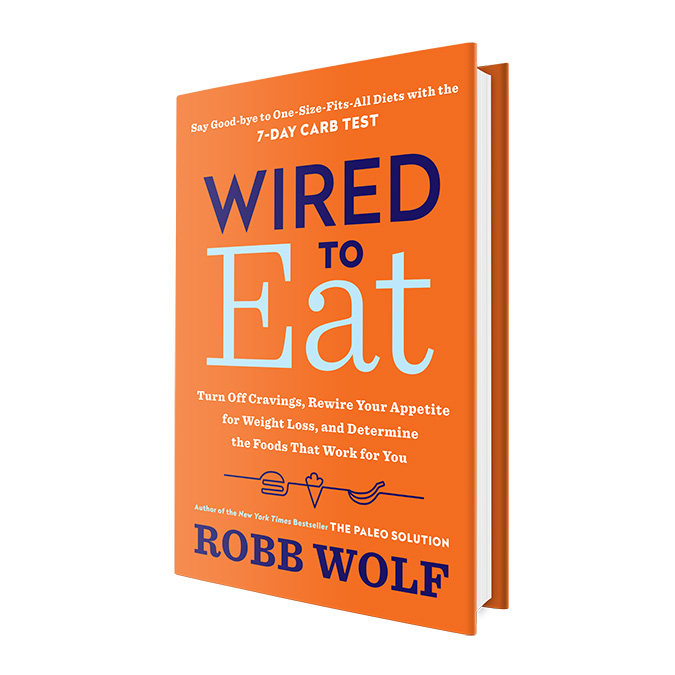The Foundation for Good Health: Species-Appropriate Diet + Species-Appropriate Microbiome
By Eirik Garnas, http://darwinian-medicine.com/
Your health is shaped by the interaction that takes place between the food you eat, the microbes that colonize your body, and the genes inside your human cells. Of these things, food and microbes are the ones you have the most control over. You can’t physically change the structure of your own genome, at least not without meddling with things you probably should leave alone; however, you can change your diet and microbiome, and thereby alter how your genes express themselves.
Together, these things form the foundation upon which your health is built. On top of this foundation are all of the other factors that affect your health, chief of which are sleep, socialization, chemical exposure, stress, sun exposure, and physical activity. The reason these things are found on top of the foundation, as opposed to below it or in it, is that they all depend on the foundation below to achieve solid footing. If the foundation is weak and unstable, so will be the things on top.
If you eat an imprudent diet and your microbiome is compromised, your athletic performance and quality of sleep will also be compromised; your ability to detoxify harmful substances and convert sunlight into vitamin D will be impaired; you will be prone to develop feelings of stress and anxiety; and your desire and ability to socialize will be reduced. In other words, everything falls apart if the foundation is not solidly built.
A relationship with deep roots
The relationship between multicellular organisms such as ourselves (i.e., macroorganisms) and smaller organisms that can’t be seen with the naked eye (i.e., microorganisms) was sculpted over billions of years. Co-evolution has tied man and microbes together with firm ropes secured with tight knots. Untying these knots is not an option, as it would mean severely compromising our ability to digest food, ward off pathogens, and think and concentrate.
Rather than trying to cut the ropes or untie the knots, we should seek to strengthen and maintain the integrity of the connection. In order to achieve this objective, we first need to collect as much information about the connection as possible: what type of rope that’s used, how the knots are tied, and what the elasticity of the whole structure is like.
If we don’t get a hold of this information, we’ll likely end up causing a mess of things. We may be unable to re-tie complex knots that have started to come apart, or we may end up exposing the components of the bond to substances that diminish their durability. In other words, we could end up changing the connection in unprecedented ways; strengthening our bond with some microbes and weakening our bond with others. In our confusion, we may also attach ourselves to microbes that our bodies have rarely or never encountered before, while de-attaching ourselves from ones that have been a stable member of our tightly knit communities for millennia.
A large body of evidence shows that this is what’s happening today (1, 2, 3, 4)…
Our relationship with microbes has had its ups and downs
It’s not a novel occurrence that the relationship between man and microbes changes. This relationship has always been fluid: it’s changed over time as a result of changes in the larger environment in which the co-evolutionary processes of man and microbes have taken place. At times, such as during the Agricultural Revolution, the relationship was particularly rocky, due to the fact that we humans went from living together in small hunter-gatherer bands to grouping together in larger, unsanitary communities, thereby exposing ourselves to a range of new pathogens. Moreover, a lot more starch and sugar was incorporated into our diet, something that caused a shift in the microbiota of the mouth and gut (5).
However, while intense, it could be argued that these changes fade in comparison to those that have taken place over the past centuries. Today, we don’t have the same problem with infectious disease as early farmers did; however, we have other, perhaps equally great, or even greater, problems. Widespread use of antibiotics and other antimicrobial drugs have triggered the rise and spread of superbugs, and via our modern lifestyle practices, we’ve altered the structure and composition of our microbiotas (1, 2, 3, 4, 6).
We have lost touch with some organisms – including many bacteria, worms, and fungi – that have been attached to our species for hundreds of thousands of years, while at the same time invited new microbes into our immediate surroundings, some of which seem to be troublesome houseguests (1).
Basically, we’ve stepped into a microbial world that differs markedly from the one in which our pre-agricultural forebears found themselves.
A large body of evidence suggests that these changes have contributed greatly to the rise in type-1 diabetes, obesity, chronic depression, irritable bowel syndrome, and many other chronic diseases and health problems that have spread like fire in dry grass over the past decades (1, 2, 7, 8). In order to stop and reverse this unfortunate trend, we first need to acknowledge that the human body didn’t evolve in isolation, but rather, in the company of trillions of other creatures.
Then, I would argue that we need to examine the evolutionary path that got us to where we are today. Only then can we understand how to best go about fixing the tangled mess that is now the ropes and knots that bind humans and microbes together.
A healthy diet will only get you so far
The obvious first step towards reshaping our relationship with microbes is to change how we eat. The microbial ecosystems that were present on the bodies of our ancestors were partly shaped by the foods that our ancestors consumed. The human genome and the microbiome both evolved in response to changes in the nutritional milieu.
This is important to acknowledge, because it implies that the development of a microbiota that flows well with the human physiology is dependent on the consumption of a diet that has characteristics similar to that of the diets that were eaten by humans in the past, during the time when the human biology evolved into its present form.
The type of microbiome that is produced by an ancestral, whole foods diet looks very different from the one that’s produced by a modern, processed diet (9, 10, 11, 12). The former microbiome will be a much better match for the human genome than the latter microbiome. Some time ago, I coined the term “genome-microbiome mismatch” to refer to the state that arises as a result of environmental changes and differences in the rate of change of the human genome and the human microbiome.
When the environment of a larger organism changes, its microbiome quickly changes as well, at least if the organism’s diet is altered; however, the structure of the organism’s own genome is not going to adapt overnight. It may take tens or hundreds of generations for major changes within a species’ genome to occur, at least if the selection pressure is quite weak.
If the environmental changes are only subtle, the organism’s health and evolutionary fitness are probably not going to be majorly affected; however, if the environmental changes are profound, they probably will be. This is when a genome-microbiome mismatch may develop. The new conditions of life in which the organism finds itself may produce a microbiome that matches poorly with the organism’s genome. The novel microbiota may produce and shed a range of substances (e.g., lipopolysaccharides, bacteriocins) that trigger adverse changes in the gene expression of the host; microbes the host depends on for proper immunoregulation may diminish in prevalence or disappear completely; and some opportunistic bacteria may get a chance to proliferate.
This is what’s happening inside the body of the modern, doughnut eating human. He is, via his diet and lifestyle, selecting for a microbiota that is making him sick. A person who eats a prudent, fiber-rich ancestral diet, on the other hand, is via his diet, enforcing a nutritional environment in the gut that is compatible with his biology.
That said, by itself, eating a healthy diet may not be sufficient to make this latter person healthy. If he doesn’t harbor the complex diversity of smaller organisms that H. sapiens, over evolutionary time, have come to depend on, he will not achieve good health. If this is the situation, he also has to manipulate and diversify his microbiome; simply adhering to a healthy lifestyle is likely not going to cut it.
Here’s the key thing to remember: A species-appropriate microbiome can’t exist in the absence of a species-appropriate diet, since the consumption of a species-appropriate diet is a prerequisite for the development of a species-appropriate microbiome. However, a species-appropriate diet won’t necessarily produce a species-appropriate microbiome. If the microbiome is very degraded and/or dysbiotic, simply eating healthy most likely won’t be sufficient to salvage the microbiome.
Microbiome restoration
I’m frequently contacted by people who are sick and tired, despite the fact that they eat a healthy diet, exercise, make sure they get plenty of sleep, and do “all” of the other things that are generally recommended as part of a healthy lifestyle.
If I do an initial screening of these people’s symptoms and medical history, I typically find that a genome-environment mismatch is at the root of their problems. It may not be the only cause, but it’s typically the major one. Hence, I proceed to give them advice on how to repair their dysbiotic, species-inappropriate microbiota.
At present, it’s not firmly established what constitutes the best course of action for repairing a damaged microbiota. Moreover, capsules and drugs containing broad spectrums of microbes that are adapted to live in the human gut are not yet easily available to the public. That said, we do have a general understanding of what it takes to build and maintain a microbiome that is compatible with the human biology.
My understanding of this issue was born out of the evolutionary health model. I firmly believe that this model is the guide we should put our faith in when we set out to reconstitute our damaged microbiomes. I typically recommend a variety of different strategies, treatments, and tools to clients who harbor a dysbiotic microbiota. The types of interventions that I recommend vary depending on the client’s symptoms.
Whereas someone with a severely damaged microbiome may have to perform several microbiota transplants in order to see marked improvements in his health; someone who “only” has a mild-moderate damage to their microbiome may get away with occasionally eating small quantities of a diversity of fermented vegetables and exposing himself to bacteria associated with pets, plants, and other humans.
Last words
Before we wrap up, there are three things I wanted to point. One, a species-appropriate microbiome is not synonymous with just 1 very specific microbiome. Homo sapiens didn’t just evolve in one specific type of milieu, but rather in many different types of environments. Our microbiomes, which could be considered to be a part of our environment, evolve in response to what goes on in the larger environment. Hence, it doesn’t come as a surprise that no two humans carry an identical microbiome.
With that being said, there are certain key physiological functions that are needed across the board; functions that we depend on the microbes that colonize our bodies to carry out. I use the term species-appropriate microbiome to refer to a microbiome that falls within the parameters of what could be considered a fully functional human microbiome. In my mind, a species-appropriate microbiome is synonymous with a microbiome that provides the key genetic capabilities that over evolutionary time have been integrated into the biology of Homo sapiens.
The second thing I wanted to point out before we wrap up is that it’s not just microbes that are important in all of this. Larger organisms (e.g., helminths) also seem to play an integral role in human health.
The third and last thing I wanted to mention is that it’s important to remember that evolution doesn’t care about health, unless the health condition of the organism in question affects its reproductive success. We can’t automatically assume that the environmental conditions that predominated x number of years ago were ideal in the context of optimizing human health.
That being said, there is little doubt in my mind that when it comes to microbiome restoration, the evolutionary approach is the best approach. Only by acknowledging that the relationship between humans and microbes have deep evolutionary roots can we understand what it takes to build a fully functional Homo sapiens.
 Eirik Garnas is a nutritionist, magazine writer, blogger, and personal trainer. He’s written for several different health & fitness websites and magazines, including Paleo Magazine. He is also the founder and owner of www.Darwinian-Medicine.com, a website dedicated to ancestral health, nutrition, and evolutionary medicine. Over the years he’s helped clients of all different ages, body types, and fitness levels build a healthier, stronger body.
Eirik Garnas is a nutritionist, magazine writer, blogger, and personal trainer. He’s written for several different health & fitness websites and magazines, including Paleo Magazine. He is also the founder and owner of www.Darwinian-Medicine.com, a website dedicated to ancestral health, nutrition, and evolutionary medicine. Over the years he’s helped clients of all different ages, body types, and fitness levels build a healthier, stronger body.




Join the Discussion